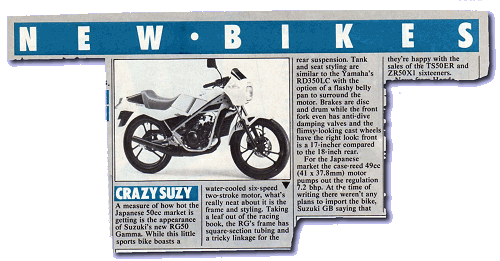It’s quite some while since IceniCAM presented a feature on a Japanese sports moped: last time was the Kawasaki AR50 in Jack the Lad, so here we go again to see how Suzuki’s comparative sports moped of the time measures up at the X-factor auditions—bring on the next contestant!
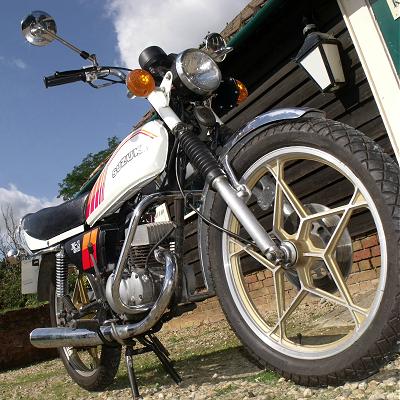 The new model Suzuki
RG50 with a 50cc
air-cooled, single-cylinder, two-stroke engine with reed valve
induction, a 7.2:1 compression ratio, and rated 6.3bhp @ 8,500rpm, was first introduced in
Japan in January 1977.
The new model Suzuki
RG50 with a 50cc
air-cooled, single-cylinder, two-stroke engine with reed valve
induction, a 7.2:1 compression ratio, and rated 6.3bhp @ 8,500rpm, was first introduced in
Japan in January 1977.
The cycle chassis comprised a simple and conventional tubular frame with 17-inch spoke wheels and a front disc brake.
A revised RG50 version with changed graphics was presented in October 1978.
A new, restyled model RG50E was released in March 1979, featuring larger diameter 18-inch Enkei star pattern cast alloy wheels, though it still used the original 6.3bhp engine design. The RG50 models were sold internationally under several guises into different world markets, being labelled as RG50, GT50, ZR50, or X1, and were governed by various levels of restricted specification as demanded by the respective markets.
Following all the accident issues with ungoverned sports mopeds, the UK had introduced a restricted 50cc specification on 1st August 1977, allowing kick-start and footrest arrangements in place of pedals, but limiting these new ‘slo-peds’ to maximum of 30mph.
The RG50 reed-valve motor output of 6.3bhp was never going to comply with the UK market 30mph limit, so Suzuki produced a plain, piston-ported cylinder to drop the power, allowing them to release a diluted version for the British market as the (ZR50)X-1, which was introduced in August 1979.
In April 1980 a new two-stage reed-valve became available for the engine in Japan, allowing a power output increase to 7.2bhp—but in Britain, we wouldn’t be getting that either.
The UK motor specification for X-1 was 41mm bore × 37.8mm stroke, with a lowly compression ratio at 6.7:1, a 15mm Mikuni carburettor, and power output given as 2.92bhp @ 6,000rpm. Standard gearing is 12-tooth front sprocket driving a 45-tooth rear.
In this feature we’re presenting the newer bike first (for reasons that will become more obvious later).
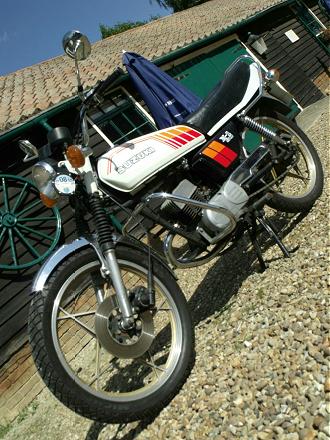 Our white (ZR50)X-1
dates from 1982, and is a nice original and completely standard
example with the 18-inch Enkei star cast alloy wheels, hydraulic
calliper disc front brake, and drum rear. It carries a
30mph-restricted
‘Slo-ped’ plate pinned to the frame, indicating
kerbside weight as 89kg—in real money that’s
196lb, or 14 stone, which is
pretty heavy for a restricted 50 (and the frame is wearing a set
of crash bars for a little more added weight, as if there’s
not enough of that already!)
Our white (ZR50)X-1
dates from 1982, and is a nice original and completely standard
example with the 18-inch Enkei star cast alloy wheels, hydraulic
calliper disc front brake, and drum rear. It carries a
30mph-restricted
‘Slo-ped’ plate pinned to the frame, indicating
kerbside weight as 89kg—in real money that’s
196lb, or 14 stone, which is
pretty heavy for a restricted 50 (and the frame is wearing a set
of crash bars for a little more added weight, as if there’s
not enough of that already!)
The cycle frame has a fairly long 50-inch wheelbase, and measures 75 inches nose-to-tail, which makes it quite a large machine for its capacity. The saddle is 25 inches long and 11 inches wide, so there’s plenty of space on there for a rider and passenger—and the frame is fitted with rear footrests so, despite the obvious lack of power, it was certainly intended to carry a pillion. The rider’s seat height is 29 inches, so that is set at a comfortable level.
Having telescopic forks with hydraulic damping, and swing-arm rear with twin shocks, the X-1 seems more like a conventional light motor cycle than a traditional moped; has goodly proportions for a 50, promising a comfortable ride; and appears sound and tidy, apart from the hideous exhaust pipe, which seems completely misshapen. Suzuki must have been having a bad day when they thought that up!
 Ignition switch
off–on–lights–park is set in a cluster between
the speedometer and tachometer, with panel lamps for neutral,
indicators, and oil warning.
Ignition switch
off–on–lights–park is set in a cluster between
the speedometer and tachometer, with panel lamps for neutral,
indicators, and oil warning.
The motor has an alloy head with a cast iron cylinder and certainly appears to be simply piston ported: there’s absolutely and definitely no reed-valve here!
The side panels wear ‘electronic’ decals so, presumably, Suzuki’s marketing was making some promotional mileage at the time about having recently fitted the X-1 with an electronic ignition set.
Probably legacies from the unrestricted RG50: a tachometer indicates up to 12,000rpm with a red-line marked at 10,000, while the speedometer indicates up to 70mph. This all looks very impressive, but we know the X-1 is a 30mph restricted slo-ped and the dials are very likely to be at long odds with actual performance, so this stuff is only there to impress the naive.
On the carburetter, click the choke lever down for on, and the motor readily starts with first kick, click the choke back up for off, but the motor seems to take ages to warm up before it’ll continue running without choke. It’s even a reasonably warm day, so maybe not so good for quick getaways?
The motor sounds tight and smooth, and this example doesn’t appear to have had much use, so should be well representative for our test.
The gear pattern gives neutral between first & second with a five-speed box, one down for first, then four up.
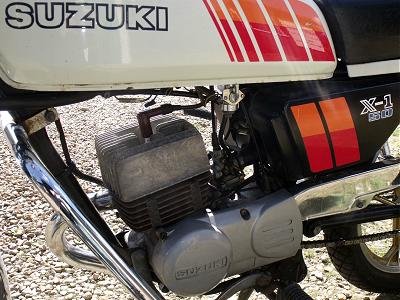 You can tell straight
away how this one’s going to perform as soon as you pull
off! Despite the obviously low first gear, you can feel the
motor is very lacking in torque, throttle response is already
poor, and it doesn’t get any better as you progress up
through the gears. The tachometer seems almost meaningless
as you can only just about get up to 7,500rpm in first (revs build only
slowly and reluctantly—you have to hold the throttle wide
open and wait for it … yes, wait for it … just a
little longer … anytime soon … nearly there now),
then click up to second, and it’s the same slow response
again, only this time the ceiling is about 6,800rpm. Third gear struggles
to 6,500rpm, fourth
is barely able to get to 6,000rpm, and fifth is just a hopeless
overdrive where you’ll constantly find yourself clicking
back down to try to recover speed that you’ll even lose on
the flat! The motor performs so poorly that you can be
forgiven for thinking there might be something wrong with
it—as it happens, there is: it’s restricted!
You can tell straight
away how this one’s going to perform as soon as you pull
off! Despite the obviously low first gear, you can feel the
motor is very lacking in torque, throttle response is already
poor, and it doesn’t get any better as you progress up
through the gears. The tachometer seems almost meaningless
as you can only just about get up to 7,500rpm in first (revs build only
slowly and reluctantly—you have to hold the throttle wide
open and wait for it … yes, wait for it … just a
little longer … anytime soon … nearly there now),
then click up to second, and it’s the same slow response
again, only this time the ceiling is about 6,800rpm. Third gear struggles
to 6,500rpm, fourth
is barely able to get to 6,000rpm, and fifth is just a hopeless
overdrive where you’ll constantly find yourself clicking
back down to try to recover speed that you’ll even lose on
the flat! The motor performs so poorly that you can be
forgiven for thinking there might be something wrong with
it—as it happens, there is: it’s restricted!
 Generally along the
flat, X-1 struggles to get to 30, then struggles to hold 30 if
you’ve managed to get there in the first place. You
quickly become aware that you’re riding it flat-out
everywhere simply to try and get where you’re going at
whatever barely moderate pace the bike can hardly manage.
You’re constantly changing through the gearbox to try and
find a bit more pull and get up some revs against all the various
prevailing conditions. Having five gears just about gives
you some chance to maintain a reasonable urban pace if you try
really hard, but the X-1 has a feeble and pathetic engine that
makes the bike a complete misery to ride.
Generally along the
flat, X-1 struggles to get to 30, then struggles to hold 30 if
you’ve managed to get there in the first place. You
quickly become aware that you’re riding it flat-out
everywhere simply to try and get where you’re going at
whatever barely moderate pace the bike can hardly manage.
You’re constantly changing through the gearbox to try and
find a bit more pull and get up some revs against all the various
prevailing conditions. Having five gears just about gives
you some chance to maintain a reasonable urban pace if you try
really hard, but the X-1 has a feeble and pathetic engine that
makes the bike a complete misery to ride.
Because of the overdrive fifth gear, we wondered if X-1 might be able to build up a good downhill run speed, so we picked a particularly long descent gradient, tucked down behind the clocks, and totally wrung its neck, but the best we could just about get it to creep up to was 36–37mph and, as soon as the slope levelled back onto the flat, the speed fell straight off to barely 30 again.
The shallowest uphill gradient will have you clicking down to fourth before you even reach the slope, then down to third as soon as you hit it.
It’s almost pointless quoting on-flat performance figures, since the conditions have to be optimum to achieve and maintain just small fractions beyond 30mph, and any expectation will only be returned with disappointment.
 Our second red X-1 is
an earlier 1980 machine, which had previously suffered the
over-enthusiastic attentions of some amateur tuner, who had
enlarged the exhaust port to such a degree that the engine would
now barely run.
Our second red X-1 is
an earlier 1980 machine, which had previously suffered the
over-enthusiastic attentions of some amateur tuner, who had
enlarged the exhaust port to such a degree that the engine would
now barely run.
Taking off the cylinder barrel, we find a huge cavity in the crankcases as witness that the motor was originally designed to accommodate reed-valve induction, but a big lip of iron on the cylinder now covers the reed cave, and X-1’s motor is simply piston ported. The transfer ports are also very small and low—clearly not intended for producing power at revs.
Consigning this original barrel to the scrap bin (clang), an ‘un-messed’ replacement was acquired, but this desperately needed a rebore. Since the standard 41mm Suzuki cylinder has a considerable thickness of metal in its liner, the thinking was that rather than simply bore to the next size up, it may just as well be bored larger to try and gain a bit more go…
Oversize piston sets all seem to be pretty much the same price, and there’s little additional cost to cut out more metal on a rebore, so what compatible sizes of piston might be available? Well, lots actually! As it happens, pretty much a full range from standard 41mm right up to 48mm, at which we’re not sure there’d be much sidewall left in the cylinder.
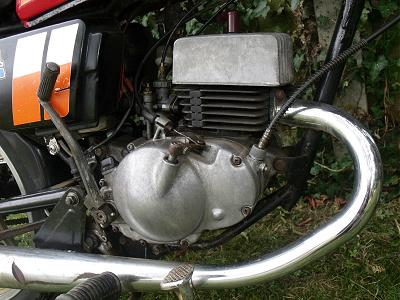 This cylinder was bored
out to 46.5mm, giving
64.2cc, which also pushes
the compression ratio up to 8.8:1.
This cylinder was bored
out to 46.5mm, giving
64.2cc, which also pushes
the compression ratio up to 8.8:1.
With a 39-tooth rear sprocket fitted (replacing the standard 45-tooth), this gears up the final drive by 13%, which might seem a fair increase considering the standard bike felt over-geared. The theory behind this is that the restricted transfer porting will continue to prevent the increased capacity motor from achieving many more revs, so the idea is to use the increased torque to pull more speed.
We didn’t get an opportunity to run the bike on a dyno, so the new power output would be purely down to speculation.
All other aspects seemed exactly the same as our first test machine, excepting the ignition system. The electrics on this earlier X-1 comprise a 6-Volt system supported by a battery. No fancy electronic stuff here, this ignition system is just good old fashioned contact points with a capacitor and remote HT coil, so all very traditional with easily available parts and cheaply serviceable.
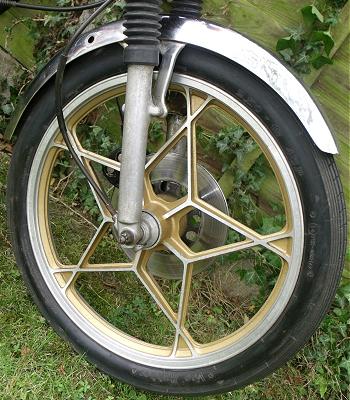 Fitted with
2.50×18 tyres on the correct Enkei star-pattern alloy
wheels, which were specially made for Suzuki, and the same ugly
exhaust pipe shape, the style is identical to our first
machine.
Fitted with
2.50×18 tyres on the correct Enkei star-pattern alloy
wheels, which were specially made for Suzuki, and the same ugly
exhaust pipe shape, the style is identical to our first
machine.
The frame is pinned with the same 30mph ‘Slo-ped’ plate, and same given weight of 89kg.
The frame plate gives the actual model as ZR50K (the K suffix appears to be the Suzuki year code), so a bit of a mystery why the bikes were marketed with X-1 on the decals?
A conventional lever petrol tap under the left-hand centre of the tank proves so stiff to turn that we need a pair of pliers to operate it (not an uncommon complaint apparently, they reportedly often seize up completely!)
Click the choke lever down on the carburetter, a couple of kicks and the motor readily starts, but seems to take ages to warm up before it’ll continue running without choke. The carburetter has been correctly re-jetted to suit the capacity increase, and it’s a reasonably warm July day, so these bikes just don’t seem to like cold running whatever is done to them.
The motor sounds well used and a little rattley. Possibly magneto-side main bearing? Probably best to not think about that too much.
Clutch, one-down for first, off we go; first runs out about 10mph, up for second to around 18mph, up for third—25mph; into 4th, which can pull up to 35mph, then fifth… This motor runs steadily along at full throttle on the flat around 6,500rpm at 40mph. Running against a headwind or light incline can readily drop this back to 35mph. Tuck down on flat with a tailwind and the tachometer can be worked up to 7,000rpm, indicating around 42–43mph, but the moment you sit up again the speed drops off again. A downhill run saw 7,500rpm on the tachometer with 45mph on the clock, but the bike would never sustain these revs without the aid of gravity.
 You’re never
going to redline this motor however hard you try—we
don’t think you could even redline it in neutral!
You’re never
going to redline this motor however hard you try—we
don’t think you could even redline it in neutral!
The gear-change shifts OK, but feels a bit notchy through some changes, sometimes requiring variable degrees of foot pressure to ‘encourage’ the shift.
This bike handled well enough for its improved performance, despite the damping having completely failed in both rear shocks, so the back end was as bouncy as a latex power ball.
Our ‘big-bore’ X-1 is certainly a considerable improvement on the standard machine, since it now has the torque to at least manage hills more capably and maintain a steady pace along the flat, but it still wouldn’t be even faintly comparable to an unrestricted reed-valve RG50.
X-1’s basic limitations are restricted cylinder porting, lack of a reed-valve, low compression, a small carburettor, and a complete inability to pull itself along in any of its gear ratios.
Restricted sports-50s are generally dreadful machines. They look as if they should go, but simply don’t. Due to having multiple gears and a complete lack of power, it always feels like there’s something wrong with them and that the engines are not working properly. They’re just miserable things to ride.
Back in Japan, Suzuki presented a new RG50 liquid-cooled ‘Gamma’ in December 1982. Now with a 6-speed transmission and engine power rated at 7.2bhp in a reduced-weight chassis down to 62kg, performance was given at 120km/h in still air on a level road, in top gear at 11,000rpm, and the days of its air-cooled sports-50 models were now counting down on borrowed time.
UK market highway-compliant restricted versions of the Gamma would, however, never be available with that kind of performance. The ZR50 X-1 was dropped off UK model listings in June 1985.


